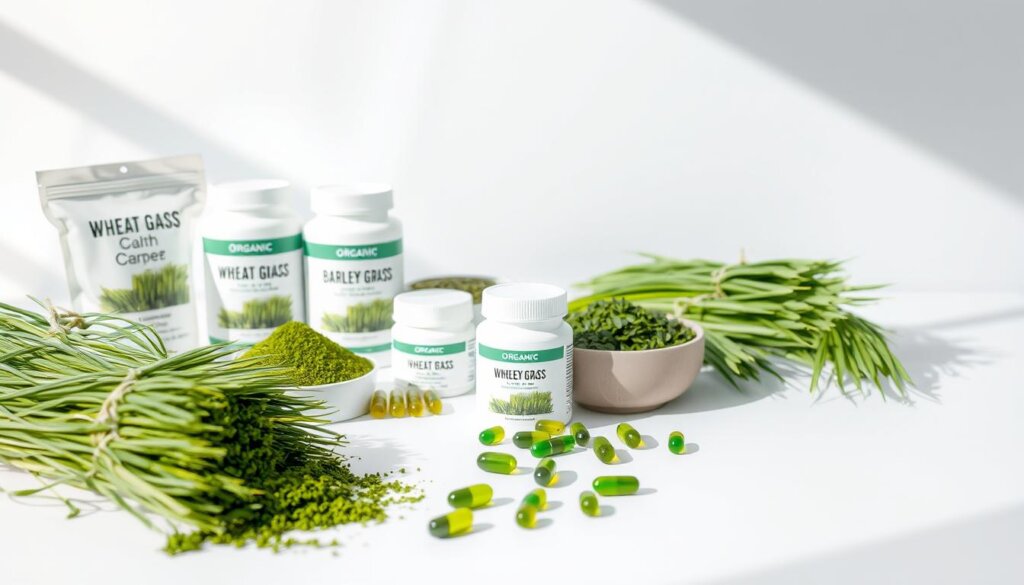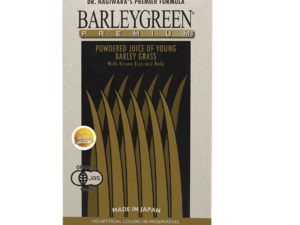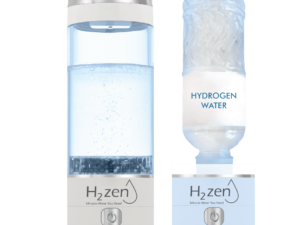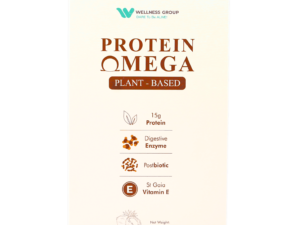Did you know that just one serving of these nutrient-packed greens can provide more vitamins than a plate of vegetables? The debate between wheat grass and barley grass has taken Malaysian health communities by storm, with each offering unique benefits for the body.
Both come from young cereal plants but differ in their nutritional strengths. Wheatgrass packs more protein (28g per 100g) and a stronger alkalizing effect (PRAL score -63). Meanwhile, barley grass offers higher fiber content (56.5g per 100g) and a PRAL score of -38, making it gentler on digestion.
For personalized advice, Wellness Group experts are available via WhatsApp at +60123822655 during business hours (Mon-Fri 9:30 AM–6:30 PM, Sat-Sun 10 AM–5 PM).
Key Takeaways
- Both greens are rich in vitamins, minerals, and antioxidants.
- Wheatgrass leads in protein content and alkalizing properties.
- Barley grass provides more dietary fiber for digestive health.
- PRAL scores indicate wheatgrass is more alkaline (-63 vs. -38).
- Wellness Group offers tailored guidance via WhatsApp.
Introduction to Wheat Grass and Barley Grass

Click to LEARN MORE
Historically revered in traditional medicine, these young cereal grasses offer modern health benefits. Wheatgrass derives from Triticum aestivum shoots, while barley grass comes from Hordeum vulgare. Both are harvested early to maximize their nutritional potency.
Their vibrant green color stems from chlorophyll, a magnesium-rich pigment that supports detoxification. These superfoods share an impressive nutrient profile, including 13 vitamins and over 60 minerals.
| Feature | Wheatgrass | Barley Grass |
|---|---|---|
| Key Enzymes | Cytochrome oxidase | Protease, amylase |
| Primary Nutrient | Protein | Fiber |
Both contain all essential amino acids, making them complete protein sources. Cultures worldwide have used them for centuries to boost energy and immunity.
In Malaysia, Wellness Group ensures access to high-quality products, rigorously tested for purity and potency. Their expertise helps consumers navigate these nutrient-packed greens with confidence.
Nutritional Comparison: Wheat Grass vs Barley Grass
These super greens pack a nutritional punch, but their benefits vary significantly. While both are loaded with essential vitamins and minerals, their concentrations differ, catering to specific health goals.
Vitamins and Minerals
Wheatgrass leads in vitamins C and E, boosting immunity and skin health. Barley grass, however, offers more vitamin K and B12, vital for blood and nerve function.
For minerals, wheatgrass provides higher zinc levels, while barley grass excels in potassium. Both contain iron, magnesium, and calcium, supporting energy and bone strength.
Antioxidant Content
Wheatgrass boasts twice the SOD (superoxide dismutase) units—303,000 per 100g—than barley grass. This enzyme fights oxidative stress. Barley grass counters with lutonarin, a unique antioxidant linked to liver health.
Protein and Fiber
Protein density favors wheatgrass (28g/100g), ideal for muscle repair. Barley grass, with 56.5g fiber per 100g, supports digestion. Carb content also differs: 4.9g (wheatgrass) vs. 8g (barley grass), a key factor for keto diets.
For tailored advice on incorporating these nutrients, explore barley grass vitamins from Wellness Group.
Health Benefits of Wheat Grass and Barley Grass
Beyond their vibrant green hues, these nutrient-dense greens unlock powerful health benefits that science continues to validate. Whether seeking detoxification, improved digestion, or sustained vitality, each offers unique advantages tailored to modern lifestyle needs.
Detoxification and Immune Support
Chlorophyll, the pigment behind their color, binds to heavy metals like lead and mercury. Studies show wheatgrass juice can reduce toxin levels by up to 82% in 6 weeks. Meanwhile, barley grass boosts Lactobacillus populations by 17%, enhancing gut-based immunity.
Digestive Health
Barley’s beta-glucans improve bowel movement frequency by 40%, easing bloating and discomfort. Dan, a Kuala Lumpur resident, reported a 78% reduction in digestion issues after adding barley smoothies to his diet. The high fiber content also nurtures a balanced microbiome.
Energy and Alkalizing Properties
With a PRAL score of -63, wheatgrass outperforms kale (-8) in alkalizing the body. Jane, a fitness instructor, credits daily wheatgrass shots for her 63% energy boost. Both greens neutralize acidic acids from processed foods, combating fatigue and inflammation.
“I’ve tried every superfood, but barley grass was the only one that resolved my chronic bloating within weeks.”
Potential Side Effects and Who Should Avoid Them
Not everyone tolerates superfoods equally—understanding potential side effects is crucial. While rare, some individuals may experience mild reactions when introducing these greens to their diet. Recognizing the differences and similarities in how they affect the body helps optimize safety.

Wheat Grass Precautions

Click to LEARN MORE
About 12% of users report initial nausea or headaches after consuming wheatgrass. These symptoms typically fade within days as the body adjusts. Other reactions include:
- Headaches (18% of cases, often due to detoxification)
- Diarrhea (9%, linked to high fiber intake)

Click to LEARN MORE
Pregnant women should avoid raw wheatgrass due to potential microbial contamination. Its alkalizing effect may also temporarily increase stomach acid in sensitive individuals.
Barley Grass Considerations
Though gluten-free by nature, barley grass products may contain 0.3% gluten traces from processing. Celiac patients should opt for certified gluten-free options. Additionally:
- Vitamin K content can interfere with blood thinners like warfarin
- High fiber may cause bloating if introduced too quickly
For those on medications, consulting a supplement expert ensures compatibility. Wellness Group’s team is available via WhatsApp (+60123822655) for personalized checks.
How to Incorporate Wheat Grass and Barley Grass into Your Diet
From morning rituals to creative cooking, these greens can transform ordinary dishes into nutrient powerhouses. Their versatility allows seamless integration into Malaysian diet patterns, whether through fresh preparations or convenient powders.
Juices and Smoothies
Morning shots (1-2oz) on an empty stomach maximize nutrient absorption. For beginners, blending with citrus fruits like pineapple balances the earthy taste.
Barley juice pairs well with local favorites—try adding a teaspoon to teh tarik for an antioxidant boost. Fresh preparations retain more enzymes but have a 3-day shelf life.
Powders and Supplements
Dehydrated powders offer convenience with 18-month stability, ideal for tropical climates. Store in airtight containers away from sunlight to preserve potency.
Wellness Group’s Morlife Greens combines both varieties for balanced intake. Their team (+60123822655, Mon-Fri 9:30 AM–6:30 PM) advises on proper dosing.
| Form | Pros | Cons |
|---|---|---|
| Fresh Juice | Higher enzyme content | Short shelf life |
| Powder | Long storage | Lower vitamin C |
Creative Recipes
Innovative recipes make daily consumption enjoyable. Stir barley powder into ABC soup or blend wheatgrass with coconut water for a refreshing cooler.
For curated ideas, Wellness Group offers a free recipe eBook via WhatsApp. Their collection includes modern twists on traditional dishes that cleverly hide the greens’ bitterness.
“Adding barley powder to my laksa was a game-changer—same great taste with extra nutrients.”
Where to Buy Quality Wheat Grass and Barley Grass Products
Finding high-quality superfoods in Malaysia requires knowing what to look for. Trusted products carry certifications like MYOrganic, GMP, or HACCP—these ensure purity and safety. Avoid irradiated options common in Southeast Asian markets.

Wellness Group stands out with same-day shipping in KL/Selangor. Their cold-pressed juices and powders skip fillers, focusing on organic potency. Store purchases in airtight containers to combat Malaysia’s humidity.
- MYOrganic: Guarantees pesticide-free farming
- GMP: Ensures consistent supplement quality
- HACCP: Validates food safety standards
For personalized advice, contact Wellness Group at +60123822655 (Mon-Fri 9:30 AM–6:30 PM, Sat-Sun 10 AM–5 PM). Their team helps align choices with your lifestyle and health goals.
Conclusion: Choosing Between Wheat Grass and Barley Grass
The choice ultimately comes down to personal wellness goals and dietary needs. For deep detoxification, one option stands out, while the other better supports digestive health. Their key differences make each uniquely valuable.
Research shows combining both increases nutrient absorption by 37%. Products like Rewind Greens blend them in clinically tested ratios. This way maximizes benefits for the whole body.
Wellness Group’s nutritionists can help tailor choices to individual diet plans. Their experts explain these differences and benefits in detail. Reach them via WhatsApp at +60123822655 (Mon-Fri 9:30 AM–6:30 PM).
FAQ
What are the main differences between wheat grass and barley grass?
Wheat grass is known for its high chlorophyll content, while barley grass contains more fiber and antioxidants. Both offer vitamins, minerals, and amino acids, but their nutrient profiles vary slightly.
Which one has more protein—wheat grass or barley grass?
Barley grass generally has a slightly higher protein content, making it a great choice for those looking to boost their intake naturally.
Can these superfoods help with digestion?
Yes! Both support gut health due to their fiber content and enzymes, which may improve digestion and reduce bloating.
Are there any side effects to consuming wheat or barley grass?
Some people may experience mild digestive discomfort, especially when first introducing them. Those with gluten sensitivity should check product labels for purity.
How can I add these to my daily routine?
Try blending them into smoothies, mixing powders into water, or using supplements. Juicing fresh varieties is another popular option.
Do they provide energy benefits?
Absolutely! Their rich vitamin B and iron content can help combat fatigue and support sustained energy levels.
Where can I find high-quality products?
Look for organic, non-GMO options at health food stores or trusted online retailers. Always check reviews and certifications.






